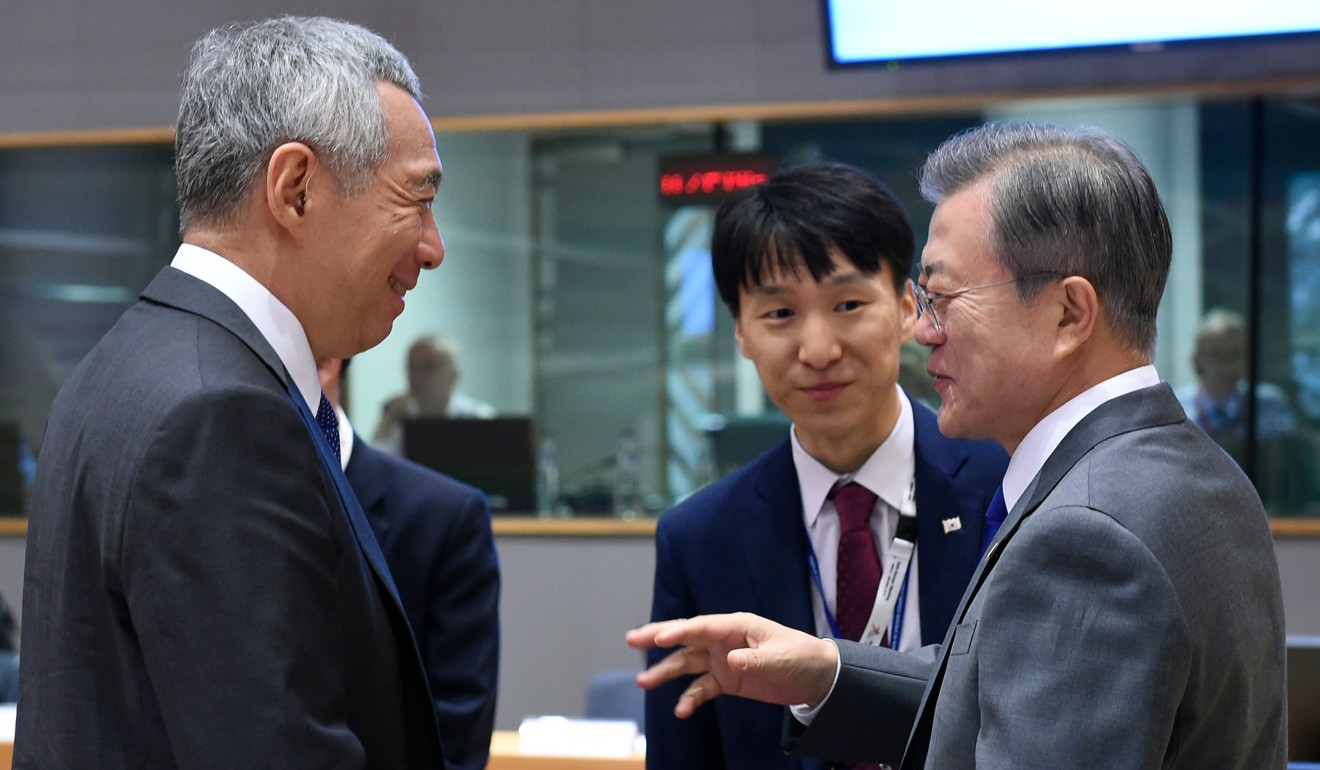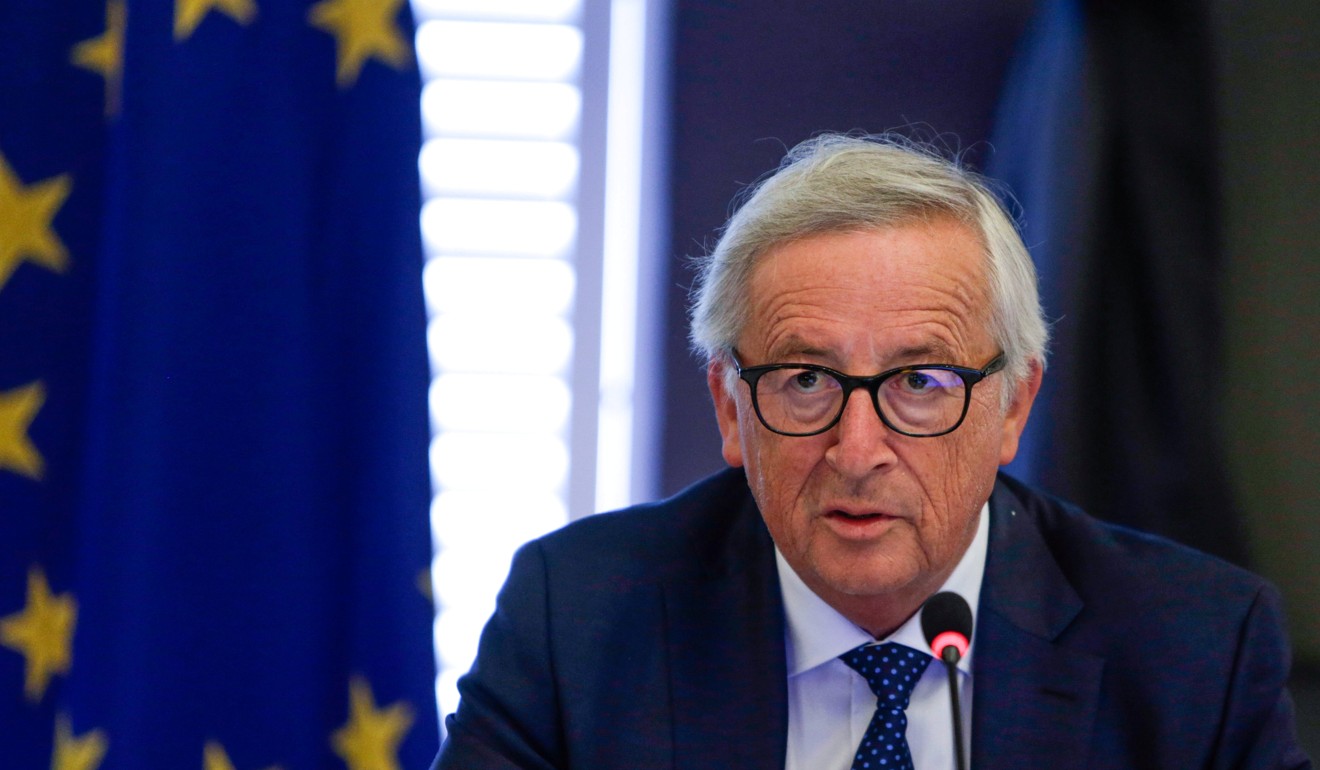
EU emerges as champion of free trade with Singapore deal
- Benefits of the EU-Singapore FTA include the elimination of tariffs between both parties in five years
- The deal is seen as a stepping stone for the EU, which is eyeing a wider deal with the Asean bloc
Against the backdrop of rising protectionism and a raging trade war, two stout proponents of free trade have shown there is another way: a free flow of goods and services.
The European Union and Singapore signed the EU-Singapore Free Trade Agreement, which will boost services, improve market access, and see tariffs between both parties eliminated in five years.
In signing the deal on Friday, Singapore’s Prime Minister Lee Hsien Loong, President of the European Council Donald Tusk and President of the European Commission Jean-Claude Juncker pledged to continue pushing for global free trade.
“The signature of the EU-Singapore agreements is a strong message by like-minded partners to defend and promote an international system based on rules, cooperation and multilateralism,” said Juncker.
Lee called the deal a high quality agreement that will significantly benefit companies from both parties.
China and Europe join WTO challenge to Trump metals tariffs, opening new front in trade war
The FTA, expected to come into force next year, will enhance protection and market access for services providers, investors and firms, boosting trade both ways.
Britain remains in the deal for the time being, but it seems likely that come March, when it leaves the EU, it will have to begin its own negotiations.
In 2017, bilateral trade grew to US$98.4 billion, making up slightly more than 10 per cent of Singapore’s total trade. Singapore is the EU’s largest trading partner in the Asean region.
Observers hailed the sealing of the FTA, noting that both parties will benefit significantly from the deal. More importantly, the FTA is a major boost for free trade at a time when countries around the world are starting to erect walls.

For Singapore, the FTA will help make its exports to Europe more competitive, especially those in the pharmaceutical, electronics and petrochemicals sectors. Companies will also be able to start exporting processed food products such as fishballs, ikan bilis (anchovies) and roti prata (a type of flatbread) tariff-free up to a prescribed annual quota.
These sectors make up nearly 10 per cent of Singapore’s GDP. But more than that, the EU FTA is part of the trade-reliant economy’s broader strategy to ensure that it keeps free trade lanes open.
To date, it has signed more than 20 FTAs with various economies and regions, making it one of the most connected economies in the world, noted DBS economist Irvin Seah.
No deal at Brexit summit, as EU leaders and UK’s Theresa May agree to take more time
“The element of certainty that these FTAs provide, particularly against the backdrop of an increasingly challenging trade landscape, will also enhance Singapore’s appeal as a strategic investment destination for multinational companies hoping to diversify their operations to Southeast Asia,” he said.
The EU, on the other hand, is unlikely to see much tangible benefit from the FTA given the size of the deal relative to its entire economy.
Oxford Economics lead euro zone economist Angel Talavera believes the deal is a stepping stone for the EU, which is also eyeing a wider deal with the bloc of Asean countries, one of the fastest-growing regions in the world.
“Following the recent FTA signed with Japan, it does show the EU is keen on expanding its trade ties with regions that have not been big trading partners until now, and in that sense, it does open the door for further deals with Asean countries in the future,” Talavera said.

The FTA also holds political significance for the EU, which is rapidly emerging as the foremost champion of free trade.
In July, the EU signed a free-trade pact with Japan, creating the world’s largest free-trade bloc. It is also negotiating deals with Korea, Vietnam, Indonesia, Malaysia and Australia, noted Dr Fraser Cameron, director of the EU-Asia Centre.
“It shows that the EU is indeed positioning itself as a champion of free trade at a time when protectionism is on the rise globally,” Talavera said.
He added that with Brexit negotiations ongoing, such FTAs were being used as bargaining chips by the EU to pressure the UK.
Singapore outclasses Hong Kong when it comes to average home size
On a broader level, these moves represent a significant shift of EU foreign policy, with a sharp pivot to the East. With US President Trump turning frosty, the EU is casting its eyes to less traditional partners, including economies in Asia, Cameron said.
“The EU has been pivoting towards Asia for some time but the move has accelerated under Trump,” Cameron said.
Indeed, President Trump could end up becoming a catalyst to creating a free trade “coalition of the willing”, led by the EU, Japan and Canada, said Nick Marro, an analyst at the Economist Intelligence Unit.
“The retreat of the US from its global leadership role and its caustic approach to multilateral trade bodies risks upending major trade institutions, such as the WTO,” Marro said.
“The EU has stepped up its trade promotion, but we also have seen Canada, Australia, Japan and others actively engaged in promoting free trade ideals.”
